Tales from the eBay Crypt
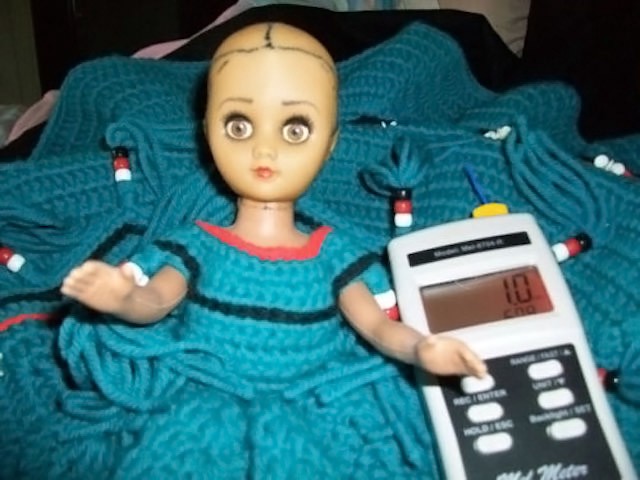
A few months ago, an oval medallion embossed with an enamel seagull sold on eBay for ten dollars, plus another two bucks for economy shipping. The previous owner of the charm, a young man named Bobby K., was a surfer. Every chance he got, Bobby would throw on his lucky necklace and head to the beach, sometimes alone, sometimes with friends, sometimes with his girlfriend, Jean.
One day, Bobby went on a beer run with a friend. On the way, the car was hit by a drunk driver and Bobby was killed. After Jean returned from the hospital, she noticed an odd glint from her dresser: Bobby had left his necklace behind. Jean held onto it for years. Sometimes she spoke into it, and sometimes it spoke back; she knew it was Bobby.
Years went by, and Jean found another man to love. He wanted her to put the past where it belonged, and asked her to sell the necklace. It landed in the hands of a jewelry collector, who put it on eBay with details about its tragic history. “Bobby is still attached to it, and feels abandoned and lost,” the seller writes. “He needs a new home with someone who can spare him time and attention.”
At the bottom of the listing, the seller notes, “eBay requires that we include the disclaimer that any article listed as haunted, paranormal, magical or mystical is offered for entertainment purposes only.”

On eBay, do a search for “haunted” — cross-referenced with a search for “active” in order to clear Halloween-themed items — and you’ll get dozens of dolls, boxes, crystals, Ouija boards, and other pieces of regular-looking furniture that contain a little something extra special inside of them. These items are hawked by a slew of sellers, from full-fledged businesses that specialize in only selling ghost-enhanced artifacts, to regular folks who just want Uncle Wally’s old stuffed animal out of the house because it’s creeping them out.
Michelle Reid is an eBay seller that falls somewhere in between. From a strip mall off the 101 in Newbury Park, California, she presides over a collection of “rare, one-of-a-kind” pieces of furniture and home decor at Unique Antiques and Collectibles. Whenever she needs to make room for new pieces, she turns to eBay to clear out stale inventory. While most of her wares are standard estate-sale fare like leather dining table chairs and art deco cabinets, a part of the store is reserved for oddities from the world of “metaphysical, paranormal, and Freemasonry.” Some of these items come with that little something extra special. “I sell items I know are haunted,” Reid said, though she does not always reveal this information to prospective buyers. (“Unless I feel it’s causing a problem I probably would not offer that information.”)
Reid carefully words the listings of potentially haunted items, since guarantees of any sort — good luck, bad luck, any luck — and she risks the posting being flagged and discarded. “You have to put that the perception you got from it can’t be guaranteed,” she said. “It has to be very careful, because they can take it down.” (eBay didn’t respond to inquiries about the rules for listing haunted items.) Once a sale is made and shipped out, Reid reaches back into her cache of haunted objects — which, in the past, she supplemented with items from Creepy Hollows, on online retailer that specializes in paranormally enhanced pieces, until it raised prices to the point “you have to take a mortgage out” — and puts the next one up.
Paintings, portraits, dolls and clothing seem to collect the most spirits. Mirrors are consistently inhabited too, which makes sense, seeing as they’re the window to the soul and all. But really anything could be haunted. “I had a broach that looked like a regular broach, but there was something more in it,” Reid said. “There’s energy on it, you can feel it.” Strangely, chairs seem to collect more than just their normal assortment of ghastly body vapors. That may have to do with how the now-deceased person felt about it when they were alive, which surely says all sorts of things about The American Aging Experience. “This was your grandfather’s favorite chair, and now his energy is passed to the chair,” Tim Weisberg, author of Haunted Objects: Stories of Ghosts on Your Shelf, told me. “So, when you bring the chair into your house, you see your grandfather sitting in the chair.” If you want to delve into the “scientific” explanation — that is to say, the pseudoscience of ghost attachment — there’s the theory that once-adored items act as a spiritual sponge. “People believe an item becomes haunted because there’s an emotional attachment.”
Of course, with the “value added” attached to the ghostly item, sellers can charge a premium cost. An ordinary barcalounger might go for forty-five dollars, but throw a ghost in that sucker — you can transfer a ghost into a non-haunted item with a “transmute bag” that Creepy Hollows sells for thirty-seven dollars — and watch that price skyrocket. “If you have had an item you were trying to sell that languished, you could just list it as haunted and it’d sell faster,” said Weisberg. “It could double or triple the asking price.” One can see the temptation for a seller to simply close their eyes and come up with a story about how this DVD copy of Happy Gilmore was somebody’s now-dead nephew’s favorite movie, and the skipping is his way of trying to communicate from beyond. “A lot of the stuff on eBay, people just make up a story,” Weisberg said.
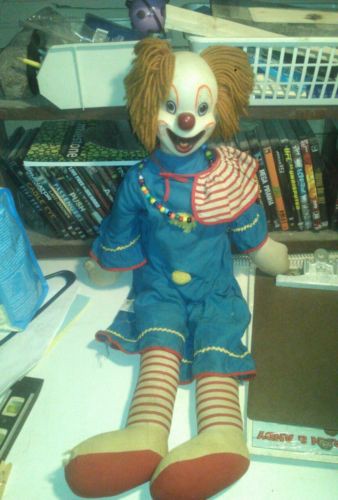
As one tale from an eBay listing for haunted doll named Kurtis goes, (mirrored here) Kurtis was “always literally clowning around.” After enough friends suggested he should give stand-up comedy a try, he did. But the transition between being real-life humorist and stage comedian didn’t take. One tragic day, at the age of twenty-eight, Kurtis died in a car accident after “having a little too much to drink.” Because he was always the jokester, Kurtis chose the utterly creepy 1961 Knickerbocker-designed clown doll as the vessel for his spirit. “He is very active on ghost speaker,” wrote the seller, “and I have heard his voice on hack radio.” (This is a cheap radio that’s been modified in order to pick up signals from the beyond; there are tons of How To videos online for how to mod one properly.) The end of the listing points towards the other big selling point for those interested in buying Kurtis. “Bought him from Sherri,” wrote the seller, “he was on tv show haunted dolls episode shipping wars.”
That weird collection of words is code for an oft-cited — in the arena of haunted object sales, at least — 2014 episode of A&E’s Shipping Wars. The show follows independent shippers trying to transport objects from point A to point B, with this particular episode highlighting a squeamish shipper tasked with moving a box of haunted dolls across the country. The eBay seller’s sales pitch, then, is that this doll is not only haunted, but was also one of the dolls featured on the episode. The pitch worked: While Kurtis failed to sell for the initially proposed hundred dollars, it ultimately found a home for the marked-down price of eighty dollars. The buyer, in their feedback, claimed Kurtis made “a welcome addition to the spirit family.”
But if you scan through the frenetically-edited comic relief section of the episode, wherein our shipping heroine deals with the mental ramifications of packing and transporting haunted dolls there’s no clown in the motley crew. “There have been quite a few people who have tried to use my name in selling a doll or spirited item,” AJ from AJ’s Haunted Dolls — the business highlighted in the Shipping Wars episode — wrote to me in an email. “The seller was a customer of mine, but I decided to quit adopting out to her because of things like this. She’s also made YouTube videos and tried to get more money for an object she previously purchased from me.”
Haunted objects aren’t like buying bike tires that will work on anyone with a bicycle; the previous owner having a spirit connection doesn’t always translate to the next buyer. But being on this show is proof that someone, at the very least, claims it previously worked, which is as close to verification as this business gets. There’s no money-back guarantee, no stamp of approval if the spook never shows. The only way to know for a fact if the object works for you is to press that buy button.
“My suggestion is to purchase a spirit doll and experience the paranormal realm first hand,” wrote eBay seller Momma Crow to me after an inquiry into her items. “But bid with care, lovely, as inviting the paranormal into your home can be exciting and addictive.”

In 1922, an Italian immigrant named Anthony Andriotti loaded his Sears construction kit onto a train, rode it to the city of Clovis, California, found open land near the station, and began building. The end result was a lavish eight-thousand-square-foot mansion with five bedrooms, a ballroom, even a swimming pool in the basement. Soon afterward, Andriotti died of cirrhosis of the liver. In 1935, the property was transformed into Hazelwood Sanitarium to treat the terminally ill. While the name changed over the years, it wasn’t until 1992 when the hospital finally saw the last patient expire within its walls.
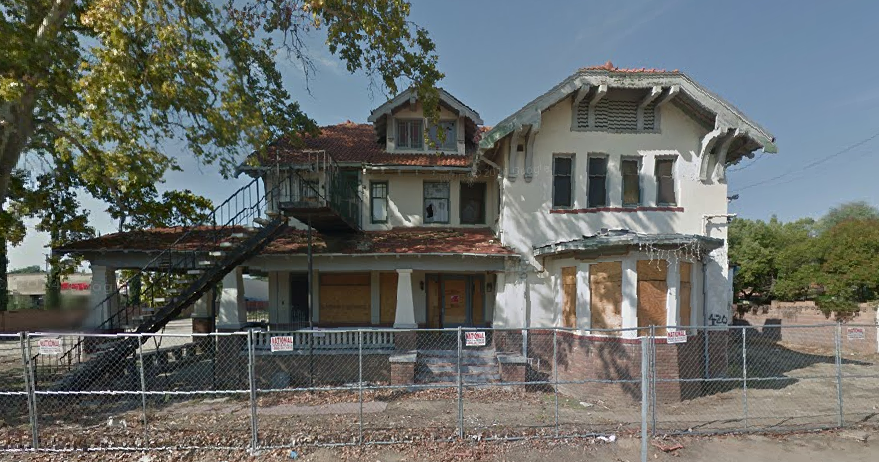
Todd Wolfe came across the property in 1996 while looking for a creepy locale to host a Halloween-season haunted house attraction, eventually named “Scream If You Can.” At its peak, Wolfe saw twenty thousand annual visitors walk through the doors to have the beejesus scared out of them. “I didn’t buy the house because it was haunted,” Wolfe said. But if you believe Wolfe’s stories — a cast member pulled by an unseen force, disembodied breaths on the back of Wolfe’s own neck — the overwhelming amount of ghostly occurrences converted the skeptical showman. “I’ve been touched,” he said. “What it is, I can’t tell you. But I have evidence.”
In 2004, the city of Clovis forced Wolfe to shut down the attraction after a series of noise complaints. He toyed with the idea of converting the space into a boutique hotel before pivoting back to ghosts. He began broadcasting weekly webcasts from the property to examine the spooky goings-on in the house, which lead to bookings on ghost-hunting TV shows, the mansion’s near-century-old glory captured through the green-tinted night vision lenses of Ghost Hunters and Ghost Adventures. Among the episodes is, what Wolfe purports to be, indisputable evidence of a haunting.
With fame came break-ins, looters, ruckuses, and kids starting fires, because that’s what kids do. Eventually, the Clovis City Council, tired of fielding complaints about the property, found a loophole to expedite its demise: Building codes. The city gave Wolfe two choices: “Remodel the house, meaning ADA ramps, electrical, new driveways, parking lot, that’d cost seven hundred and fifty thousand dollars,” said Wolfe. “Or tear it down.” Protesters tried to halt the destruction — an online petition garnered over a thousand signatures — but in the end, Wolfe wouldn’t spend that much money on a dying property. Before the bulldozers arrived, Wolfe, ever the entrepreneur, went into the property one last time and removed every damn thing that wasn’t bolted down.
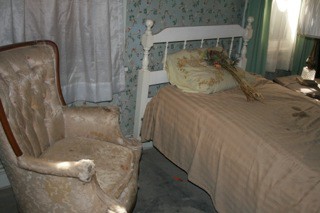
After Clovis tore down the mansion last November, the objects began their after-afterlife. “A thousand items, if not more, will go on eBay,” Wolfe said. Since then, he’s listed old bed pans, original wallpaper, antique salt and pepper shakers, gold-plated tiles, an old Craftsman fireplace. The first item sold was a plaque of a cherub that hung over the bed of Mary, one of the Manor’s many ghosts. After a furious bidding war, it sold for five hundred and sixty dollars.
Each listing is a lesson in apparitional salesmanship. The word “haunted” appears throughout, along with a photo of the item’s appearance on one of the TV shows. “That helps sell the items,” said Wolfe, “oh my goodness, yes.” He no longer starts sales at ninety-nine cents, as he found it turns off buyers; the “Buy It Now” option’s gone for the same reason. Wolfe begins each auction at nineteen dollars and lets the market dictate from there. Each listing contains a red-bolded, sixteen-point-font declaration to potential buyers: “You are buying this at your own Risk!” Wolfe said that this is not because of eBay’s rules, but to indemnify himself. “Don’t you get mad at me if something weird follows this item,” he wrote at the end of his posts.
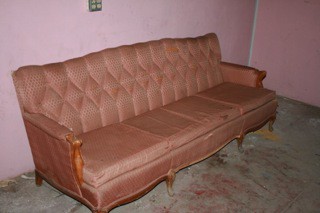
Over the past year and change, Wolfe has sold thirty different pieces of the Wolfe Manor. A quick scan of the items he’s received “Feedback” on puts his earnings near five thousand dollars. A vast portion of that is from a lone buyer, who’ll fight “to the bitter end” to win nearly every auction, including most of the mansion’s old tiles. “This lady’s spent two hundred and sixty dollars on the same tile,” Wolfe said. “A tile for two hundred and sixty bucks!” According to Wolfe’s calculations, “the lady” has purchased ninety-eight percent of the items he’s put up. “I don’t get it,” he said, “but whatever.”
The “lady” is actually a couple, Nancy Savattere and Henry Maass. (Wolfe’s misunderstanding comes from the couple using Nancy’s email address on eBay auctions, while in reality, Henry does the purchasing.) So far, they’ve bought a framed picture, interior panels, bedsheets, a candelabra, and tiles, many, many, many tiles. They also bought an old Jello mold (for seventy-six dollars) and a haunted horseshoe (for ninety-one dollars). In all, Henry believes they’ve purchased about twenty-four pieces, for an average price of around a hundred and seventy dollars per item.
There is a thought experiment called the Ship of Theseus that goes like so: A ship needs a new plank, so a worker removes the plank, tosses it into the river, replaces it. The ship needs another, so the worker removes the old plank, tosses it in the river, replaces it. On and on it goes, every plank removed and tossed, until the ship no longer contains any original pieces. At the same time, another builder is downstream, collecting every discarded plank and using them to construct his own ship. Eventually, the second ship is complete. So: Which is the actual Ship of Theseus? The first, which contains none of the original pieces? Or the second, which contains them all?
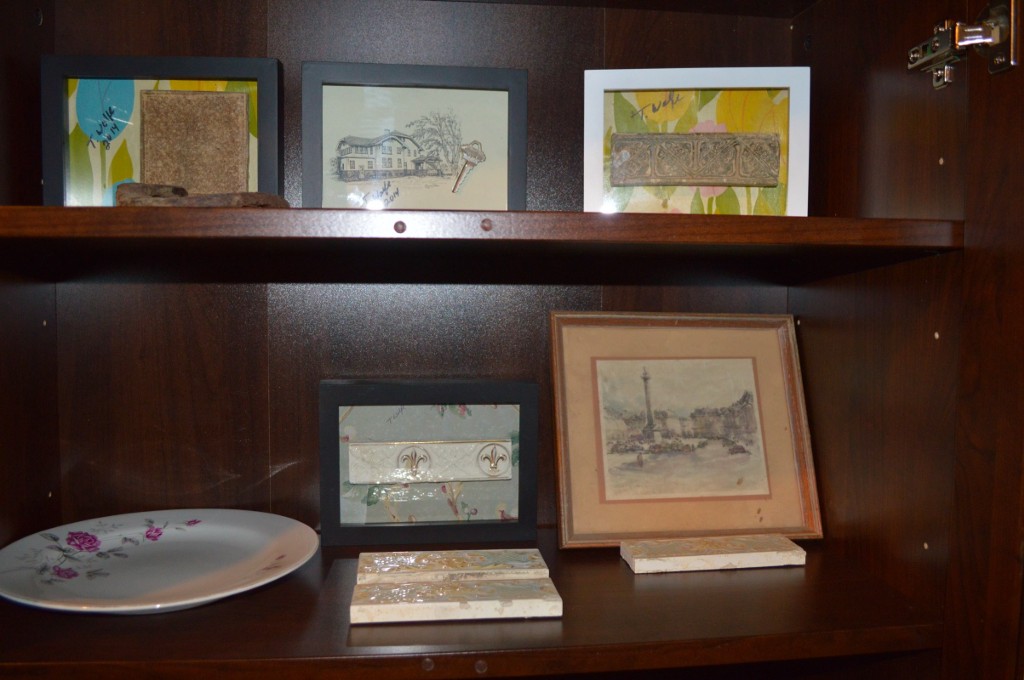
The experiment may not be a perfect comparison — you can’t build a second Wolfe Manor without the original structure — but if anyone’s in a position to do so, it’s Savattere and Maass. The items are kept in glass display cases, next to other historic memorabilia like a 1855 bookcase and a piece of Italian wood dated to 1492. Not every item has exhibited spiritual activity, but that is the hope when they are purchased. “I’m a collector, don’t get me wrong,” Maass said. “But a lot of paranormal people — it’s a weird if-you-want-to-call-it a fetish or hobby or oddity — we collect thinking that there’s something attached to it.” And while the Wolfe Manor cache offers no guarantees of haunted activity, they do offer something nearly as good: Proof of where they came from. “We know the provenance of this place,” Maass said. “That’s what gets a lot of people. ‘Oh, this is a haunted.’ Uhhhhh, no. Research before you start bidding. Unless I know for a fact it came from this place that says this activity happened, I won’t touch it with a ten-foot pole.”
Maass’s fascination with the afterlife started when he was twelve, after his mother died. That was four decades ago, during an era when ghost-hunting equipment wasn’t ubiquitous and cheap to obtain. His initial investigations relied on flashlights and thirty-five-millimeter cameras, but those were enough for Maass to find the experiences he craved. “I can tell you right now, some I’ve had, have not been positive, believe you me,” said Maass. “I’ve seen things come out of the ground, sprout legs, and walk off. And I’m thinking, ‘Huh, that’s all you got?’”
Fourteen years ago, while working at UPS, Maass met Savattere. The two gravitated towards one another, despite Savattere being married at the time. After it dissolved, the two “island babies” — Maass was born in Hawaii, Savattere in Puerto Rico — quickly got together. With her own background in Santería, Buddhism, and other forms of spirituality, Savattere embraced Maass’s ghost-hunting excursions. It’s certainly advantageous that Savattere is experienced with creepy happenings, because the Wolfe Manor items have turned out to be… lively. “Things are really hopping,” Maass said. One notable experience occurred when Maass went to start the fireplace and, out of nowhere, a giant shadow appeared and walked towards him. “I could’ve reached out and touched it.” When Savattere later stood in the same location, she witnessed the same exact thing. “I’m like, yup,” Maass said. “I get that off and on.”
The eBay auctions and in-house hauntings are sort of a way to stay in shape for their own amateur on-site investigations. In 2013, the duo participated in what would turn out to be the final paranormal investigation into The Pride House of Jefferson, Texas; four days later it burned down in a fire. However, the duo’s in-person probes have been put on the back burner. Earlier this year, Nancy’s ex-husband died, leaving the ghost hunters with a fourteen-year-old boy in their care. Maass believes that some of the activity in the house is the boy’s father trying to communicate from beyond, and that, one day, he’ll succeed in delivering whatever message he has. “It may be ten, twenty years before [his dad] says something to him,” he said. But it’s coming, that’s for sure. Maass knows because he’s already made contact. “It’s a disembodied voice, I’m the only one in the room, looking around going, okay,” Maass said. “And I hear him say, ‘take care of her.’”
In between tidying up the ex-husband’s estate — as well as learning-on-the-fly to take care of a teen full-time — the couple continues to watch Wolfe’s listings, waiting anxiously for the day when the big ticket item finally gets put up: The basement couch with the above-mentioned “video evidence” of a ghost plopping its whispery non-ass down onto it.
When it finally gets listed, and when they surely buy it, Nancy and Henry will truck the haul back themselves to keep the shipping costs reasonable. And after loading up the couch, they’ll make a slight detour on over to 2674 Clovis Avenue and check out that vacant lot where the Manor used to reside, where all those haunted objects used to linger. And before they start up the car and head on back home to Texas, they’ll have a nice, long look at the place where all their ghosts used to live.
Photos of Wolfe Manor items and the Maass collection courtesy of Todd Wolfe and Henry Maas; all others via eBay
